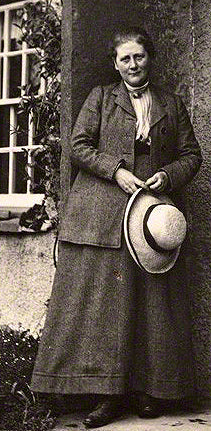Helen Beatrix Potter (1866–1943) is best remembered today as the beloved creator of The Tale of Peter Rabbit, a character who has charmed children for more than a century. Yet to confine Potter to the realm of children’s literature is to miss the vast dimensions of her legacy. She was a pioneering conservationist, a gifted mycologist, a keen businesswoman, and a woman who, against Victorian convention, carved a fiercely independent life from the quiet contours of the English Lake District. Her story is as rich and multi-layered as any she told on the page.
Early Life: Victorian Confinement and Imagination’s Escape
Beatrix Potter was born on July 28, 1866, into a privileged Unitarian family in South Kensington, London. Her father, Rupert Potter, was a barrister by training but rarely practiced law, preferring photography and art. Her mother, Helen Leech, came from a family of wealthy cotton merchants. Like many women of her class, Helen occupied herself with household management and strict adherence to Victorian social norms.
Despite their wealth, the Potters were socially isolated. Beatrix and her younger brother Bertram were raised largely by governesses. Their education was informal and home-based, with Beatrix receiving only sporadic instruction in languages, history, and science. But what she lacked in formal schooling, she made up for with voracious curiosity and imagination.
From a young age, Beatrix found solace in sketching and observing the natural world. Her pets—rabbits, mice, frogs, even a bat—became subjects of study and affection. These animals often served as both muses and models for her early drawings, which were executed with remarkable anatomical accuracy and charm.
In the family’s regular summer holidays to Scotland and later to the Lake District, Beatrix encountered landscapes that would haunt her imagination for life. She recorded the flora and fauna with a naturalist’s precision and an artist’s eye. These retreats also sowed the seeds for her future as a storyteller.
Mycology and Scientific Curiosity
In her twenties and thirties, Beatrix Potter’s attention turned with intensity to the study of fungi. At a time when women were largely excluded from scientific circles, she developed significant expertise in mycology, producing hundreds of detailed drawings and watercolors of spores, fungi, and lichen.
Her interest was more than artistic. Fascinated by the way fungi reproduced, she conducted experiments and developed her own theories of germination. In 1897, she submitted a paper to the Linnean Society of London, a prestigious scientific body. Titled "On the Germination of the Spores of Agaricineae", it was delivered on her behalf by a male mycologist—Potter, as a woman, was not permitted to attend.
Though her findings were initially dismissed by the male-dominated scientific establishment, modern mycologists have acknowledged the value of her observations. Her illustrations, in particular, remain prized for their accuracy and beauty. The Natural History Museum in London houses over 450 of her drawings.
Potter’s foray into science was ultimately curtailed by the barriers placed before her as a woman. Yet the episode reveals the depth of her intellectual rigor and the complexity of her mind—a mind constantly at play between fantasy and empirical observation.
The Tale of Peter Rabbit: From Private Letter to Global Icon
The genesis of Potter’s literary career is both quaint and emblematic of her creative process. In 1893, she sent an illustrated letter to Noel Moore, the son of her former governess, about a mischievous rabbit named Peter. Years later, encouraged by friends and recognizing the story’s potential, she self-published The Tale of Peter Rabbit in 1901 after facing rejection from several publishers.
With its simple prose, anthropomorphic animals, and delicate illustrations, the book was an immediate success. Frederick Warne & Co., which had initially declined the manuscript, quickly reversed course and offered to publish it. The first commercial edition appeared in 1902, selling out rapidly.
Beatrix Potter insisted on creative control—an unusual demand for a debut author, particularly a woman. She chose the small book format herself, arguing it would be suitable for small hands. She also refused to oversentimentalize her characters, maintaining a certain psychological truth behind their animal façades.
Peter Rabbit was followed by a series of other “little books” over the next two decades: The Tale of Squirrel Nutkin (1903), The Tale of Benjamin Bunny (1904), The Tale of Mrs. Tiggy-Winkle (1905), and many more. Each one was rooted in the landscapes she loved and populated by creatures rendered both charming and complex.
By 1910, Beatrix Potter was a literary phenomenon and one of the most successful children’s authors of all time. Her tales were translated into multiple languages, and her characters were adapted into toys, games, wallpaper, and merchandise—an early example of cross-media branding.
Tragedy and Transformation: Loss and the Lake District
Though her professional life flourished, Potter’s personal life was marked by heartbreak. In 1905, she became engaged to her editor, Norman Warne, against her parents’ wishes—he was, in their view, socially inferior. Just a month later, Warne died suddenly of leukemia. The loss devastated Potter.
That same year, seeking solace and a measure of independence, she purchased Hill Top Farm in Near Sawrey, a village in the Lake District. The move marked a turning point in her life. At Hill Top, she immersed herself in the rhythms of rural life—breeding sheep, managing land, learning traditional farming practices. It was not a hobby but a vocation. She became a respected member of the local agricultural community and developed a deep commitment to land preservation.
Over the next few decades, Potter used the profits from her books to buy up vast tracts of land in the Lake District, including farms, woodlands, and fell pastures. She feared the encroachment of tourism and urbanization and sought to protect the region’s cultural and ecological integrity.
Her vision found a powerful ally in the National Trust, a conservation charity founded in 1895. In her will, she bequeathed over 4,000 acres of land to the Trust, including 15 farms. Today, her legacy endures not just in books, but in the very landscapes she fought to preserve.
Later Life and Enduring Influence
In 1913, at the age of 47, Beatrix Potter married William Heelis, a local solicitor who had helped her with property purchases. Unlike her parents, Heelis respected her autonomy and shared her passion for the countryside. Their marriage was quiet and contented, spent largely in Near Sawrey.
Potter continued to write, though at a slower pace. Her later works—The Tale of Little Pig Robinson (1930) and The Fairy Caravan (1929)—reflected a broader range of themes and styles, though none matched the enduring popularity of her earlier tales.
She also gradually withdrew from public life, devoting herself to farming, especially the breeding of Herdwick sheep, a hardy local breed. In 1942, she became the first woman elected President of the Herdwick Sheepbreeders’ Association, though she died before taking office.
On December 22, 1943, Beatrix Potter passed away at the age of 77. She left behind not only a body of literary work that had transformed children’s literature but also a landscape permanently altered by her vision of preservation.
Legacy: Beyond the Nursery
Beatrix Potter’s legacy is profound and multifaceted. As an author and illustrator, she revolutionized the picture book format, emphasizing narrative integrity, visual elegance, and emotional subtlety. Her characters endure not merely because they are cute, but because they contain traces of human complexity. Peter Rabbit is curious but disobedient; Jemima Puddle-Duck is maternal yet naïve; Mr. Tod is villainous but strangely tragic.
As a conservationist, she was decades ahead of her time. Her commitment to preserving the Lake District laid the groundwork for future environmental activism in Britain. Her land donations formed the nucleus of what is now a UNESCO World Heritage Site.
In scientific circles, her early work in mycology is being reevaluated and appreciated anew. The same mind that created charming talking animals also dissected spores and sketched fungi with clinical precision.
Feminists, too, have come to see her as a figure of resistance: a woman who defied the constraints of Victorian domesticity, who earned her own living, made her own decisions, and crafted a life of meaning and autonomy.
And of course, there are the children—millions of them—who continue to meet Peter Rabbit for the first time, their imaginations stirred by his hop through Mr. McGregor’s garden. In the best children’s literature, fantasy and reality coexist. In the life of Beatrix Potter, they did as well.
The Quiet Radical
Beatrix Potter remains one of the most quietly radical figures in modern cultural history. She did not shout, she did not preach, and she did not seek the limelight. Yet through ink and watercolor, land deeds and livestock, she reshaped the contours of art, literature, and conservation.
Her life reminds us that the worlds of the imagination and the material world are not separate but intertwined. The garden gate that Peter Rabbit slips through is, in a way, the same gate through which Beatrix Potter stepped—away from the confines of Victorian society and into a life entirely her own.
In an era still grappling with questions of environmental preservation, gender roles, and the role of art in shaping identity, her example remains not only relevant, but quietly revolutionary.

